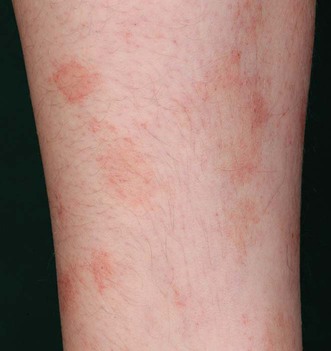Barnhill RL, Braverman IM. J Am Acad Dermatol 1988; 19: 25–31.
Capillaritis (pigmented purpuric dermatoses)

Management strategy
 Drugs (14% in one series), e.g., acetaminophen, acetylsalicylic acid, bromine-containing drugs, carbamazepine, furosemide, interferon-α, non-steroidal anti-inflammatory drugs (NSAIDs), raloxifene (selective estrogen receptor modulator), thiamine. As a rule, drug-induced capillaritis is more generalized and does not usually present with epidermal involvement or lichenoid infiltrate. Other reported triggers include dietary supplements (creatine) and the ingredients of an energy drink (vitamin B complex, caffeine, taurin).
Drugs (14% in one series), e.g., acetaminophen, acetylsalicylic acid, bromine-containing drugs, carbamazepine, furosemide, interferon-α, non-steroidal anti-inflammatory drugs (NSAIDs), raloxifene (selective estrogen receptor modulator), thiamine. As a rule, drug-induced capillaritis is more generalized and does not usually present with epidermal involvement or lichenoid infiltrate. Other reported triggers include dietary supplements (creatine) and the ingredients of an energy drink (vitamin B complex, caffeine, taurin).
 Chronic infections such as viral hepatitis B or C or odontogenic infections.
Chronic infections such as viral hepatitis B or C or odontogenic infections.
Specific investigations
Progression of pigmented purpura-like eruptions to mycosis fungoides: report of three cases.
![]()
Stay updated, free articles. Join our Telegram channel

Full access? Get Clinical Tree










